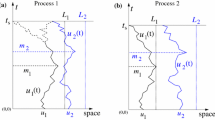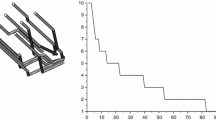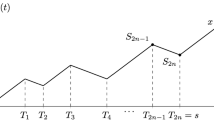Abstract
For n + 1 particles moving independently on a straight line, we study the question of how long the leading position of one of them can last. Our focus is the asymptotics of the probability pT,n that the leader time will exceed T when n and T are large. It is assumed that the dynamics of particles are described by independent, either stationary or self-similar, Gaussian processes, not necessarily identically distributed. Roughly, the result for particles with stationary dynamics of unit variance is as follows: \( L: = - \ln p_{T,n}/(T\ln n) = 1/d_{0} + o(1), \)where d0/(2π) is the power of the zero frequency in the spectrum of the leading particle, and this value is the largest in the spectrum. Previously, in some particular models, the asymptotics of L was understood as a sequential limit first over T and then over n. For processes that do not necessarily have non-negative covariances, the limit over T may not exist. To overcome this difficulty, the growing parameters T and n are considered in the domain \( c\;{\text{ln}}\;T < n \le CT \) where c > 1. The Lamperti transform allows us to transfer the described result to self-similar processes by changing the \( \ln p_{T,n} \) normalization to the value \( \ln T\ln n \).
Similar content being viewed by others
References
Aurzada, F., Simon, T.: Persistence Probabilities and Exponents, Levy Matters. Lecture Notes in Mathematics, vol. 5, pp. 183–224. Springer, Cham (2015)
Aurzada, F. and Mukherjee, M.: Persistence probabilities of weighted sums of stationary Gaussian sequences. arXiv 2003.01192 (2020)
Autezana, J., Buckley, J., Marzo, J., Olsen, J.-F.: Gap probabilities for the cardinal sine. J. Math. Anal. Appl. 396(2), 466–472 (2011)
Banueles, R., Smits, R.: Brownian motion in cones. Probab. Theory Relat. Fields 108, 299–319 (1997)
Bramson, M. and Griffeath, D.: Capture problems for coupled random walks (in Random Walks, Brownian Motion and Interacting Particle Systems In: Durrett, R., Kesten, H. (eds). 153–188 (1991)
Bray, A.J., Majumdar, S.N., Schehr, G.: Persistence and first-passage properties in non-equilibrium systems. Adv. Phys. 62(3), 225–361 (2013)
De Blassie, R.: Exit times from cones in Rn of Brownian motion. Prob. Theory Relat. Fields 74, 1–29 (1987)
De Blassie, R.: Remark on exit times from cones in Rn of Brownian motion. Prob. Theory Relat. Fields 79, 95–97 (1988)
Dembo, A., Mukherjee, S.: Persistence of Gaussian processes: non-summable correlations. Prob. Theory Relat. Fields 169, 1007–1039 (2017)
Feldheim, N.D., Feldheim, O.N., Nitzan, S. Persistence of Gaussian stationary processes: a spectral perspective, arXiv:1709.00204 [math.PR], (2017)
Grenander, U., Szego, G.: Toeplitz Forms and Their Applications. University of California Press, California (1958)
Kesten, H.: An absorption problem for several Brownian motions. In Seminar on Stochastic Processes, 1991, (Los Angeles, CA, 1991), vol. 29 of Progr. Probab., 59–72. Birkh¨auser, Boston, MA (1992)
Krapivsky, P.L., Redner, S.: Kinetics of a diffusive capture process: lamb besieged by a Pride of Lions. J. Phys. A 29, 5347–5357 (1996)
Latala, R. and Matlak, D.: Royen’s proof of the Gaussian correlation inequality. Geometric aspects of functional analysis. Lecture Notes in Mathematics, 2169, 265–275 (2017), Springer, Cham
Li, W.V., Shao, Q.-M.: Capture time of Brownian pursuits. Prob. Theory Relat. Fields 121, 30–48 (2001)
Li, W.V., Shao, Q.-M.: A normal comparison inequality and its applications. Prob. Theory Relat. Fields 122, 494–508 (2002)
Li, W.V., Shao, Q.-M.: Lower tail probabilities for Gaussian processes. Ann. Probab. 32(1), 216–241 (2004)
Leadbetter, M., Lindgren, G., Rootzen, H.: Extremes and Related Properties of Random Sequences and Processes. Springer, New York (1986)
Lifshits, M.: Lectures on Gaussian Processes. Springer, New York (2012)
Molchan, G.: Unilateral small deviations of processes related to the fractional Brownian Motion. Stoch. Process. Appl. 118, 2085–2097 (2008)
Molchan, G.M.: Persistence exponents for Gaussian random fields of fractional Brownian Motion type. J. Stat. Phys. 173, 1587–1597 (2018)
Ratzkin, J., Treibergs, A.: A capture problem in Brownian motions and eigenvalues of spherical domains. Trans. Am. Math. Soc. 361, 391–405 (2009)
Royen, T.: A simple proof of the Gaussian correlation conjecture extended to multivariate Gamma distributions. Far East J. Theor. Stat. 48, 139–145 (2014)
Talagrand, M.: New Gaussian estimates for enlarged balls. Geom. Funct. Anal. 3, 502–526 (1993)
Acknowledgements
This research was supported by the Russian Science Foundation through the Research Project 17-11-01052. I am very grateful to the reviewers for a careful reading of the manuscript and helpful criticism.
Author information
Authors and Affiliations
Corresponding author
Additional information
Communicated by Satya Majumdar.
Publisher's Note
Springer Nature remains neutral with regard to jurisdictional claims in published maps and institutional affiliations.
Appendix
Appendix
1.1 Proof of Lemma 4
Following [3], we use the following representation
where K is the boundary of the square of size N, centered at the origin. On the sides of K that are parallel to the xaxis one has \( \left| {t - {\text{z}}} \right| \ge N/2,\left| {\sin \pi z} \right|^{2} = \cosh \pi N. \)
The analogous estimates for the sides of \( K \) that are parallel to the \( y \) axis are
Substituting these estimates into the integral, we obtain
1.2 Proof of Lemma 6
Let \( X(t) \) be a stationary process with covariance function \( r_{0} (t) \) and continuous spectral density \( f_{0} (\lambda) \). Then the sequence \( \{X(k\theta)\} \) has spectral function
By the assumptions, \( f_{0} (\lambda/\theta) \le f_{0} (0) \) and \( f_{0} (\lambda) \) is majorized by a monotone function \( \tilde{f}_{0} (\lambda) \in L_{1} \).Therefore
Hence, putting \( \sigma_{\theta}^{2} = \sup_{0 \le \lambda \le \pi} 2\pi f_{\theta} (\lambda) \), we get
Consider the \( m \times m \) matrix \( R_{m} = [r_{0} (i\theta - j\theta)]_{i,j = 1 - m} \). Because \( \sigma_{\theta}^{2} = \sup_{0 \le \lambda \le \pi} 2\pi f_{\theta} (\lambda) \), we have the following relation for the quadratic forms \( ({\mathbf{x}} ,R_{m} {\mathbf{x}}) = \int_{- \pi}^{\pi} {\left| {\sum\nolimits_{1}^{m} {x_{k} e^{ik\lambda}}} \right|}^{2} f_{\theta} (\lambda)d\lambda \le \int_{- \pi}^{\pi} {\left| {\sum\nolimits_{1}^{m} {x_{k} e^{ik\lambda}}} \right|}^{2} \sigma_{\theta}^{2}/(2\pi)d\lambda = ({\mathbf{x}},{\mathbf{x}})\sigma_{\theta}^{2}. \)
We will see later that \( R_{m} \) is non-degenerate. Assuming the existence \( R_{m}^{- 1} \), we have
The last one means that for any \( \{u_{i} \} \) we have
where \( \{\eta_{i},i = 1, \ldots,m\} \) are i..i.d. standard Gaussian variables, \( Q_{m} = \sqrt {\sigma_{\theta}^{2m}/D_{m}} \) and \( D_{m} = \det R_{m} \).
According to the theory of the Toeplitz forms [11], \( \delta_{m}^{2} = D_{m}/D_{m - 1} \) is the mean-square error of the \( X(0) \) prediction based on \( \{X(i\theta),i = 1, \ldots,m - 1\} \) data. Moreover, \( \delta_{m}^{2} = D_{m}/D_{m - 1} \) decreases and converges to the value \( \delta_{\infty}^{2} = \exp \{(2\pi)^{- 1} \int_{- \pi}^{\pi} {\ln f_{\theta}} (\lambda)d\lambda \} \).
Since \( f_{\theta} (\lambda) \ge \theta^{- 1} f_{0} (\lambda/\theta) \) we have\( D_{m} = \delta_{m}^{2} \cdot \delta_{m - 1}^{2} \cdot \cdots \cdot \delta_{1}^{2} \ge (\delta_{\infty}^{2})^{m} \ge \exp \{m(\theta/\pi)\int_{0}^{\pi/\theta} {\ln f_{0}} (\lambda)d\lambda \} \cdot \theta^{- m} \).Therefore
This estimate also proves the non-degeneracy of the matrix \( R_{m} \). According to (4.2), \( \theta \sigma_{\theta}^{2} = 2\pi f_{0} (0) + o(1),\theta \to 0 \).
Hence for small \( \theta \) we have \( Q_{m} \le \exp (\tilde{A}_{\theta} m/2) \) with
Obviously, \( \tilde{A}_{\theta} \) can be replaced by a non-decreasing function of \( \theta^{- 1} \), namely
where \( < \psi (\lambda) >_{\varLambda} \) is the mean of \( \psi (\lambda) \) in the interval \( (0,\varLambda) \).□
Rights and permissions
About this article
Cite this article
Molchan, G. Leadership Exponent in the Pursuit Problem for 1-D Random Particles. J Stat Phys 181, 952–967 (2020). https://doi.org/10.1007/s10955-020-02614-z
Received:
Accepted:
Published:
Issue Date:
DOI: https://doi.org/10.1007/s10955-020-02614-z




